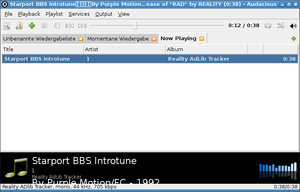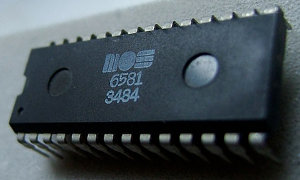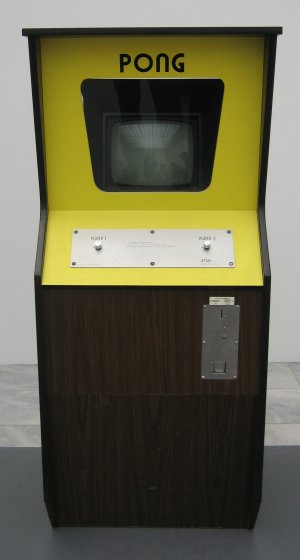Entries tagged as atari
Related tags
adplug audacious audio c64 chiptune dosbox fileformats game-music-emu gbs hvsc mikmod modplug nsf retro retrogaming sid sidplay sound ape ffmpeg gstreamer libav monkeysaudio mplayer realaudio retrocomputing shn shorten totem vlc voc vqf xine kapitalismuskritik krisis mitschnitt theorie video blinkenlights brownbox painstation pong pongmechanik pongmythos retrogames stuttgart wkv bingen breakpoint demoscene ultrasound welleerdball imagemagick legacy evoke köln arcade asia2013 computerhistory magistral moscow museum russia tankodrom donkeykong freesoftware gameboy games lucasarts mario monkeyisland nes nintendo olpc scumm simcity videogames wii blackhat computergames defcon gameandwatch lasvegas supermario travelling usa absturz bahn ccc cccs cryptography datenschutz db demokratie demonstration easterhegg environment fsf k21 lightwerk mappus openstreetmap papierlos patents plebiszit police policeviolence politik privacy protest publictransport rech s21 schuster security slides softwarepatents ssl stallman stuttgart21 talk tls traffic umwelt verkehr volksabstimmung vorratsdatenspeicherung wien windowsThursday, June 21. 2012
Tracker and other non-streamed audio formats

The Audacious audio player
Last time I talked about streamed audio formats. The basic idea with streamed audio formats is that you have a data representation of the audio waves. This is how most modern audio formats like mp3 or ogg work. This approach works well today, but it was not feasible on older computers, because it takes lots of memory. So old audio formats store some kind of meta information that a computer then uses to "compose" an audio track live.
For old audio formats, it seems the Audacious media player is the free software solution that you should look for.
C64 SID files
Probably the most famous ancient audio format is the C64 SID format. The Commodore 64 had a special chip - the SID chip - for audio which has a very distinctive kind of sound. The High Voltage SID Collection (HVSC) contains around 40.000 SID tunes (though only 60 MB in size).
To play SID files, the SID chip needs to be emulated, as they basically contain code for the chip itself. The sidplay project seems to be abandoned since a few years, but there is sidplayfp, a fork trying to keep it alive. It has its own command line player. Worth mentioning may be that the SID files you find today didn't exist on a C64, they were invented for SID players on systems other than the C64. The concept of "files" with headers as we know today wasn't really existing there.

A C64 SID chip (Image source)
ATARI SAP files
For ATARI SAP files, the story is quite similar to the SID one, although they're less popular. They contain code for the POKEY chip, which was used on 8-Bit-Atari-Computers. The Atari SAP Music Archive (ASMA) collects such music. Audacious plays the format out of the box.
Tracker formats (MOD, XM, IT)
Tracker or module formats became popular with the Amiga, which used the MOD format. It contains a couple of instruments and information how they should be played. Later, popular tracker software introduced new formats like XM (Fast Tracker 2), IT (Impulse Tracker) or S3M (Scream Tracker). Tracker formats are still popular within the Demoscene.
There are two free software solutions to play module formats - MikMod and ModPlug. MikMod was dead for a couple of years, but just recently it seems development has revived. Both played every module format I ever happened to see, so I don't make a specific recommendation. Audacious has a plugin for ModPlug.
Adlib and other small tracker formats
I'll start with a personal story here. Once I tried getting into assembler programming and created so-called 4K-Intros. I started this under DOS in a time when this was already fading out. For sound, I found a nice piece of software called the RAD tracker, which came with some assembler source code to play their own mini audio format.
There existed a couple of similar mini-tracker-formats, mostly for the Adlib sound chip. Pretty much every PC sound card in that time had the functionality of an Adlib sound chip. melcom's ChipTune Archive contains a collection of Adlib files.
AdPlug is our free software solution here and - you guess it - Audacious has a plugin for it. However, AdPlug was not able to play all the files in melcom's archive.
Edlib Tracker in DOSBox
Video Game Music
There are vast collections of sound archives extracted from old console video games. As systems like a GameBoy or a NES don't have "files", these formats have been created afterwards by enthusiasts to collect the music. There's a whole number of them, you can find samples of files like NSF (Nintendo Sound Format for NES games) or GBS (Gameboy Sound) (you'll find many samples behind the links). There's something special about these: They usually don't have one file for a track, but one file for a game. So e. g. an NSF file contains a whole buch of sound tracks.
The solution to play them is called Game Music Emu. And - you already guess it - Audacious has a plugin for that.
Conclusion
Free software plays pretty well with all kinds of strange audio formats, although the situation is a bit more scattered than with streaming music, where you pretty much have one solution for everything (ffmpeg). I stumbled at least across one case where no free software solution was available - but emulation helps out.
Audacious seems to play a central role in supporting all kinds of audio files. It's available for Linux and for Windows (although I haven't tested if it plays everything under Windows as well - comments welcome).
Saturday, April 22. 2006
pong.mythos - Ausstellung im WKV Stuttgart
 Schon seit Februar steht in Stuttgart im Württembergischen Kunstverein die Ausstellung pong.mythos. Kurz vor Ende hab ich's endlich geschafft, ihr einen Besuch abzustatten. Bilder von pong.mythos gibt's hier.
Schon seit Februar steht in Stuttgart im Württembergischen Kunstverein die Ausstellung pong.mythos. Kurz vor Ende hab ich's endlich geschafft, ihr einen Besuch abzustatten. Bilder von pong.mythos gibt's hier.Die Ausstellung dreht sich ganz um das wohl legendärste Computerspiel Pong. Im vorderen Teil findet man einige historische Spielgeräte, im hinteren Teil eine Reihe von Kunstprojekten und Installationen, die sich mit dem Spiel beschäftigen oder es in verschiedenen Varianten präsentieren.
Zum historischen Teil: Spielbar findet man einen originalen ATARI Pong-Automaten (der Schläger ist übrigens verdammt klein), sowie einige ältere und moderne Konsolenadaptionen. Viele spannende Ausstellungsstücke sind hier leider nur in Schaukästen zu bewundern, so hätte ich gerne mal auf einer echten Brown-Box gespielt. Auch ein angeblich mechanisches Pong mit namen Blip hätte ich gerne in Aktion gesehen, vom anschauen erschloss sich mir leider nicht dessen Funktionsweise. Bedauerlich, aber verständlich und ein leidiges Problem mit Computerspielen als Kulturgut.
Im Bereich der Kunstprojekte gab es einiges mir schon Bekannte zu bewundern, so etwa eine verkleinerte Blinkenlights-Variante, das mit echten Motoren und Berührungssensoren arbeitende PONGMECHANIK und sicher das heimliche Highlight der Ausstellung, die PainStation.
Bedauerlicherweise konnten wir einige der Installationen nicht spielen, da sie entweder mangelhaft dokumentiert oder teilweise nicht funktionstüchtig waren. So gab es ein MiniPong, welches mit einem Stecknadelkopf zu steuern war, jedoch auf seinem 5x7 LED großen Display nichts sinnvolles anzeigte. Beim TFT Tennis reagierte eine Seite nicht auf Drehungen. Eine mit Muskelkraft durch zwei Fahrräder zu betreibende Installation zeigte auf dem Bildschirm trotz Strampeln nur Rauschen. Ein akustisches Pong erschloß sich uns in seiner Funktion nicht.
Daneben gab es noch unter anderem eine 3D-Variante in einem LED-Würfel (3D-Pong spielt sich extrem schlecht, dachte ich mir damals schon bei pongdeluxe), ein großes LED-Pong, ein durch Gemüse (mit einer Webcam) gesteuertes Spiel, eine selstlaufende Installation, die ein Pong-Spiel aus verschiedenen wechselnden Kamerapersketiven darstellte, sowie einige Videos und Plakate von weiteren Projekten (unvollständige Liste).
Fazit: Für jeden, der sich auch nur ein bißchen für Computerspiele und deren Geschichte begeistern kann, auf jeden Fall einen Besuch wert. Die Ausstellung ist noch bis zum 1. Mai in Stuttgart, anschließend wieder auf der Games Convention in Leipzig und im August 2007 in Bern.
Vielleicht noch interessant: Die Geschichte vom originalen ATARI Pong und der Brown Box wird sehr gut in diesem Video dargestellt.
Posted by Hanno Böck
in Art, Computer culture, Retro Games
at
23:48
| Comments (0)
| Trackbacks (0)
Defined tags for this entry: atari, blinkenlights, brownbox, painstation, pong, pongmechanik, pongmythos, retrogames, stuttgart, wkv
(Page 1 of 1, totaling 2 entries)